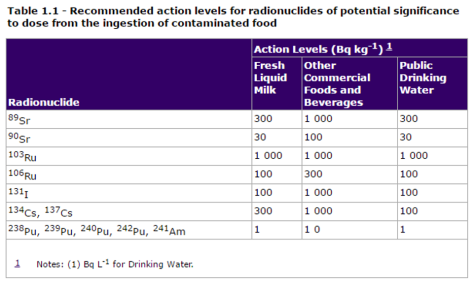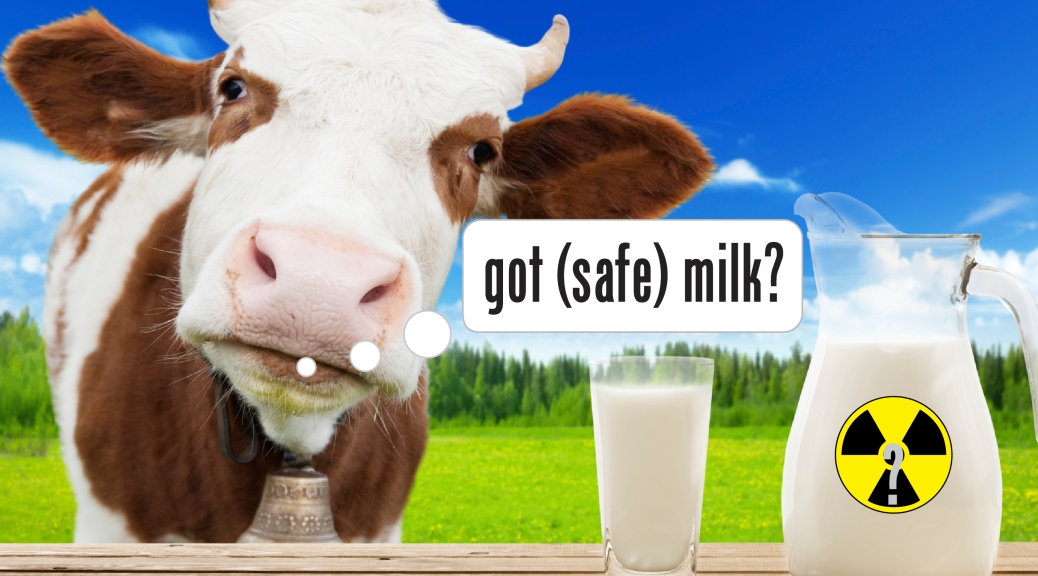April 26th marked the 30th anniversary of the 1986 Chernobyl nuclear disaster. The ~2600 sq km (~1000 sq mi) exclusion zone remains in place around the power plant and wildlife are reclaiming the habitat. Just outside the exclusion zone, the Associated Press reports that dairy farms are operating and selling milk and dairy products around Belarus and Russia. The author obtained a milk sample from one of these farms, had it tested, and found it to be contaminated with levels of strontium-90 (90Sr) that are 10 times higher than the nation’s food safety limits. At first I was alarmed that this could make it to market, however, since working for the InFORM project I’ve learned that not all limits are equal. Let’s take a gander at how this milk would fare under standards from around the world.
The milk sample is from the Milkavita supply chain and is largely used for making Polesskiye brand cheese. Ten percent of that cheese is sold in Belarus, the remaining 90% is sold in Russia. The sample was run at the state operated Minsk Center of Hygiene and Epidemiology and was found to have a level of 90Sr at 37.5 Bq kg-1 or way over the 3.7 Bq kg-1 safety standard in that country. However, each country is able to set their own guidelines for food safety that are representative of the local diet and demographics. Below is a table I was able to compile of various countries, and international organizations, who have publicly available standards for radionuclides in their food.
| Milk Sample | 37.5 Bq kg-1 | |
| Country | 90Sr Limit1 in Milk2 (Bq kg-1) |
Deemed Safe? |
|---|---|---|
| Belarus | 3.7 |  |
| United Kingdom | 10 (30 for milk products) |
 |
| Eurasian Economic Union | 25 |  |
| Canada | 30 (100 for other commercial food and beverage) |
 |
| Japan | 50 |  |
| United Nations FAO/WHO Codex Alimentarius Commission | 100 |  |
| International Atomic Energy Agency (IAEA) | 100 |  |
| Australia | 100 |  |
| European Union | 125 |  |
| United States | 160 |  |
| 1 Limit may be labeled as a limit, action level, or intervention level depending on the governing agency. See origin website. 2 Fresh milk limit where specified by source, otherwise limit may be generally applied to all foods. |
||
As you can see, the standard for Belarus is quite low when put into an international context. Also, while the milk sample would certainly fail testing if it were acquired in the UK, the Eurasian Economic Union, and Canada, the milk would be deemed safe to drink in Japan (who just recently lowered their limits), the United States, and in many other countries which have adopted the United Nations and IAEA standard.
So with this range of acceptable levels of strontium in the food supply, this begs the question of how these standards are set. This is where the science gets rather complicated. Generally speaking, limits for radionuclides in foods are set below an “acceptable” dose of radiation such that by avoiding consumption of those foods, the individual would completely avert exposure to that dose. To ascertain the maximum concentration level that would be present in the food or beverage during consumption, there must be consideration of the half-life of the radionuclide, the type of radioactive decay, and the age of the individual ingesting. For instance, the intervention level of 137-cesium, with a half-life of 30 years, is evaluated for a period of 1 year, whereas isotopes like 131-iodine, with a half-life of ~8 days, is evaluated for a period of 2 months. Examining the below table shows that level of concern also varies depending on the type of decay. Alpha rays, like those from plutonium (Pu) and americium (Am), are known to cause 10-1,000 times more chomosomal damage due to their higher energy levels during decay than beta rays (like those from strontium (Sr)), or gamma rays (as from cesium (Cs)) .

Last, the age of the individual ingesting the food or beverage is considered since different organs of the human body are most actively growing at different life stages. There are six age groups between infant (3 months) and adult (the end of puberty) that are evaluated. Generally, the most conservative action level is chosen as the benchmark among the results for all age groups.
You may also note the difference between drinking water and liquid milk vs other foods and beverages. Health Canada notes that since these liquids are “generally drawn from local sources, it is assumed that the intake consists entirely of contaminated supplies.” Meanwhile, since other foods are sourced from more distant locations, it is assumed that no more than 20% of foods and beverages from the other category are contaminated.
So, sure there are these factors between radionuclides and the types of food that are being ingested, but that still doesn’t explain why the thresholds are so different between countries, right? It all boils down to what is an “acceptable” dose of radiation to the body and each country defines that a bit differently. In the United States, the Food and Drug Administration says, “The lower level, called the Preventative [Protective Action Guide] PAG, was a projected dose commitment of 5 mSv to the whole body, active bone marrow, or any other organ except the thyroid, or a projected dose commitment of 15 mSv to the thyroid.” Meanwhile in Canada, “Based on the principle of dose and risk limitation, Health Canada regards the dose from food and water above which intervention would be warranted to be on the order of 3 mSv apportioned equally among three food groups, or 1 mSv per food group.” So right there, these two neighboring countries are defining the acceptable dose differently and when to determine that a population may have a considerable health risk.
Communicating the science of food safety is extremely important since, as consumers, we often go to the store and have faith that the food we select has met or exceeded all relevant health standards. In an effort to reassure the Japanese public following the Fukushima disaster, the Radiation Council in that country lowered the limits of radionuclides in food by 1/20 – 1/4 of the previously existing limits in the winter of 2012. The Japan Times reported that this was an effort “to provide a generous safety margin” and “the new limits are based on the false assumption that most food products are contaminated with cesium following the explosions last March.”
The new limits, and the widespread testing of foods that followed, resulted in two outcomes. The Japanese government reports that these steps resulted in multiple countries lifting or easing radionuclide-related restrictions on food imports which is ultimately important to helping the Japanese economy. However, three months after the new limits took effect a Pew Research poll found that 76% of Japanese still believed foods produced near the disaster site were not safe. Anecdotally, I have heard from colleagues who have recently traveled to Japan that many still fear about the safety of food produced from the area indicating that efforts to communicate the science of food safety are still needed.
While the Japanese government lowered limits in the wake of Fukushima to bolster domestic and international confidence in their food products and exports, it is quite likely that the very low standards in Belarus are similarly meant to reassure consumers. That said it would seem that these low limits may be based on perception more than scientific evidence and ultimately result in samples failing the tests on a more regular basis. These failed tests may then cause more public fear than is necessary based on the best available science.
Personally, I am not a radiochemist and cannot lend insight to the science behind lower or higher toxin thresholds. However, it is clear to me that these varying thresholds from one nation to another do cause some concern among the public. The story from the Associated Press was run in news outlets around the world and I would suspect caused that farmer and dairy brand financial losses. Yet, as I’ve shown, had that milk sample been from a cow in many other countries around the world, there would not have been a headline worth reporting.
Those in Canada and the United States may be interested in more locally conducted milk analyses. Health Canada has been quarterly monitoring radionuclides in milk since 1984 (only in Ottawa after 1993) and the results are publicly available. The US Environmental Protection Agency’s RadNet began sampling in milk 1976 across the country, however quarterly sampling ceased in 2014. Historic data remain available online.
Note: Not a summary of peer reviewed literature, but a commentary on an article from the Associated Press.


An excellent summary. I will circulate the link to this report through SARI, Twitter, and my numerous colleagues around the world.
LikeLike